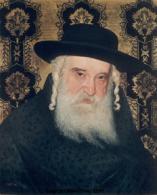 The main point of this post is to bring to your attention a specific nigun from the Kedushas Tzion that, by request of the Rebbe and Rav Benzion, we should learn and use during the davening and at tish. But as I learned more and more about the origins of the nigun, I couldn't help but share my findings as well. First, the nigun, as recorded on the Ma Ashiv album from Bobov:
The main point of this post is to bring to your attention a specific nigun from the Kedushas Tzion that, by request of the Rebbe and Rav Benzion, we should learn and use during the davening and at tish. But as I learned more and more about the origins of the nigun, I couldn't help but share my findings as well. First, the nigun, as recorded on the Ma Ashiv album from Bobov:
And now for some very interesting history about this nigun's various travels throughout the Chassidish world and its specific connection to Hornosteipel.
"The famed Bobover composer, Reb Moshe Goldman, a"h, heard from the Bobover Rebbe Reb Shloime, ztz"l, that this nigun was composed by his father, the Kedushas Tzion, ztz"l hy"d, to celebrate his chasunah in Ratzfert. This nigun became well-known because his zeida and mechuten, Rav Motele of Hornosteipel, came from Russia to the chasunah with a large entourage of his chassidim. On their return to Russia, they sang the nigun that they heard by the chassunah, and from then on it became very popular, especially amongst the chassidim of Russia."
Rav Motele's daughter, Sura Mariam, married the son of the Divrei Chaim, Reb Shulem Leizer'l of Ratzfert. They had a daughter named Chaya Fradel, who married the Kedushas Tzion. It was for that chasunah that Rav Motele traveled to Ratzfert. Apparently, the chosson's nigun caught the attention of the chassidim and they brought it back to "Russia". Think Karlin, Lubavitch, Slonim, Breslov, Chernobyl and its derivatives, and any other Chassidus that wasn't from Galicia or Polin.
 |
| Reb Yom Tov Ehrlich |
I found it, therefore, interesting to note that after a little research, I discovered that the famous Reb Yom Tov Erlich, z"l, sings this nigun on his tape, Yud Gimel Middos, and uses it to tell a story of Reb Aharon Karliner. Also, the nigun is assumed by many to actually be a Karliner nigun.
The nigun, A Toiva Far A Toiva (Song 8 on Yud Gimel Middos):
For those interested, the Yiddish lyrics can be found here. (Scroll down till ניגון ח).
 |
| The Gaavid, Rav Moshe Aryeh Freund |
The note in Magen Avos continues: "The Gaon Rav Moshe Aryeh Fruend, ztz"l, Gaavid of Yerushalayim related that his father, Rav Yisroel Freund, ztz"l, was present at a particular chassunah of Reb Shulem Leizer'l Ratzferter's family, as he was amongst the singers there. They sang this nigun of the Kedushas Tzion, but they only sang it from the second stanza and on. Rav Moshe Aryeh himself used to sing this nigun for mitzvah tantz and said that the first stanza was added at a later instance."
When the Kedushas Tzion introduced the nigun for the first time at his chasunah, it was without the first stanza, and apparently it was not meant specifically for Lo Seivoishi but as a Nigun Simcha without words.
In Bobov itself the nigun was known to a much lesser degree. There is an account from a Sanzer chasid who visited Bobov years later. He told how the chazan sang this nigun, but only the eldest of the chassidim knew it. It seems that the nigun was reintroduced at some point later on with the additional first stanza.
In Bobov itself the nigun was known to a much lesser degree. There is an account from a Sanzer chasid who visited Bobov years later. He told how the chazan sang this nigun, but only the eldest of the chassidim knew it. It seems that the nigun was reintroduced at some point later on with the additional first stanza.
The current Rachmastrivka Rebbe in Yerushalayim, is considered a talmid muvhak of Rav Moshe Aryeh, ztz"l. Here is a video clip of his own mitzvah tantz at his younger daughter's chassunah. At 1:10 on the time index, they change the nigun to the Lo Seivoshi nigun but they start at the second stanza and never sing the first - exactly as depicted in Magen Avos as the original way it was sung, even by the Kedushas Tzion.
How cool is that?
Another fascinating parallel is the Nigun Prozos Teishev Yerushalayim from Chabad. The similarities are obvious, yet it only consists of two parts. The story goes that on Kislev 19, 5729, the Lubavitcher Rebbe asked that these words be put to leibidiker music and on the spot, the chassidim came up with a nigun that until then was wordless and added the words "prazos teishev yerushalayim".
From Nichoach, Album 7:
So we see how a nigun originated in Bobov, traveled to Hornosteipel, and from there became well-known in various forms to all of Russia and Ukraine. Years later, back in Bobov, a first part was added and it was put to Lo Seivoshi. Let's relearn this nigun and make it feel once again at home in Hornosteipel.
Please comment with any other info regarding anything in this post. Thanks!
Please comment with any other info regarding anything in this post. Thanks!
If you enjoyed this post, get free updates by email or RSS.

.JPG)
No comments:
Post a Comment